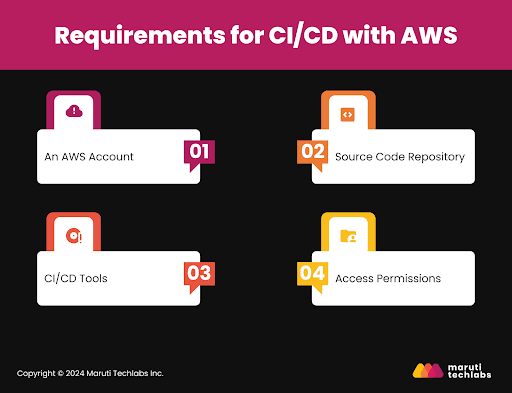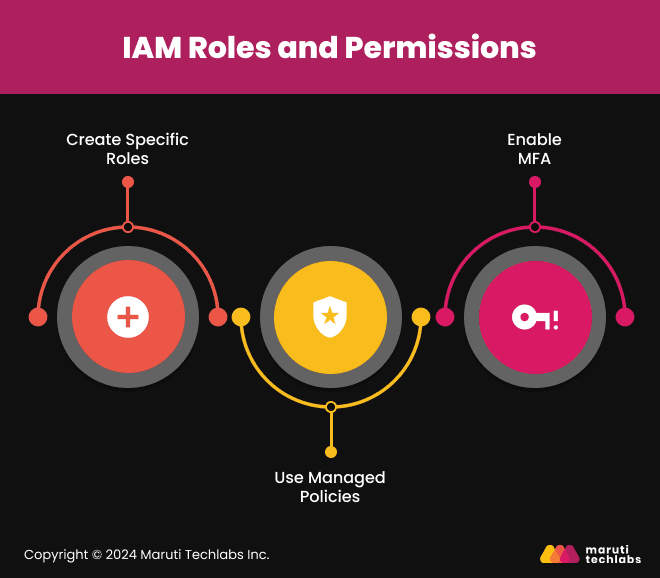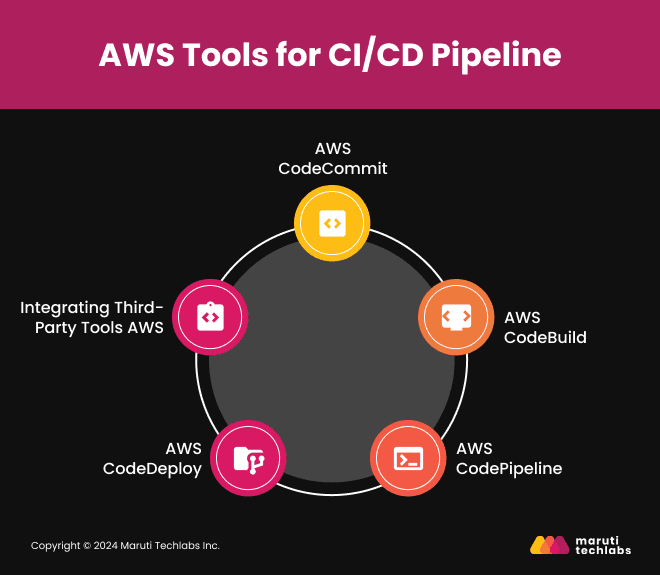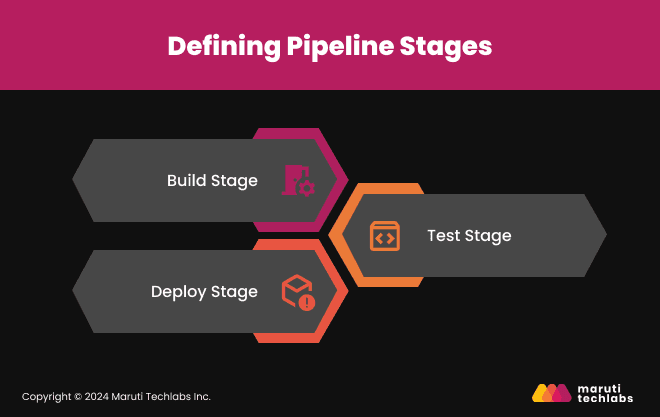

How to Seamlessly Set Up CI/CD Using AWS Services






Software development is at a tipping point, and automation is the driving force behind this revolution in automating the software development lifecycle. With CI/CD on AWS, your DevOps pipeline can become the backbone of faster, error-free deployments. However, making this work smoothly can be challenging. Many teams still struggle with outdated manual processes, unstable environments, and delays slowing their ability to innovate and deliver new features quickly.
In this blog, we’ll discuss CI/CD concepts, dive into AWS tools like CodePipeline and CloudFormation, and share proven strategies for automation, monitoring, and security.
CI/CD stands for Continuous Integration and Continuous Deployment. Continuous Integration involves merging code changes into a shared repository, triggering automated tests to catch issues early. Continuous Deployment takes it further by automatically releasing changes to production once they pass testing. This ensures smoother collaboration between developers and quicker delivery to customers.
Continuous Integration allows developers to commit code more frequently, which reduces integration issues. Tools like AWS CodeBuild conduct tests to ensure that each code addition integrates properly with the others.
Continuous Deployment automates releases, saving time and preventing human error. AWS services such as CodePipeline manage these processes, providing real-time visibility and management.
CI/CD minimizes downtime, enhances team collaboration, and accelerates delivery cycles. For example, a retail app using CI/CD can fix bugs and roll out updates without interrupting customer experiences. This agility is crucial for maintaining a competitive edge.
By implementing CI/CD, organizations can achieve several key advantages:
AWS provides robust tools for every step of the CI/CD process:
These tools integrate seamlessly, making AWS a one-stop solution for your CI/CD needs.
Setting up AWS for CI/CD is like laying the foundation for a reliable, automated DevOps pipeline. A strong setup ensures your team works efficiently and avoids common deployment pitfalls.
To start, you’ll need a few basics:

These components work together to help you create, test, and deploy applications seamlessly.
Start with a clear plan. Define your pipeline stages: source, build, test, and deploy.
For example, a startup can configure its environment to push updates daily without interrupting users. AWS provides detailed setup templates to simplify this.
Security is crucial. AWS Identity and Access Management (IAM) ensures that only authorized users access your CI/CD pipeline.

For instance, an enterprise could create a dedicated role for its DevOps team to ensure that no unauthorized changes disrupt operations.
Using AWS tools for your CI/CD pipeline ensures smooth, efficient, and reliable deployment processes. Here are some tools that can elevate your DevOps pipeline when integrated with AWS:

AWS CodeCommit is a managed Git-based repository that helps you store source code securely. It integrates smoothly with your pipeline, ensuring your team can collaborate effortlessly. For instance, a startup managing multiple projects can use CodeCommit to track changes, manage branches, and maintain code quality.
AWS CodeBuild eliminates manual tasks by automating source code compilation and testing. It supports popular programming languages, so developers don’t need extra setup.
Take a startup developing a mobile app. Using CodeBuild, they can quickly test new features without managing infrastructure. The tool scales automatically, handling spikes in build requests during high-demand phases.
AWS CodePipeline automates your application release process, connecting all stages of your DevOps pipeline. It ensures that every update, from coding to deployment, happens efficiently.
For example, an e-commerce business rolling out seasonal offers can rely on CodePipeline to deploy changes quickly. With integrations for third-party tools like Jenkins, GitHub, and Slack, CodePipeline adapts to any development workflow.
AWS CodeDeploy simplifies application deployments across many environments, including EC2 instances and on-premises servers. Consider a global firm launching updates to all of its services at the same time. CodeDeploy can prevent downtime and provide a consistent customer experience.
Integrating third-party tools with AWS enhances your DevOps pipeline by bridging gaps and tailoring workflows to business needs. Whether it’s leveraging Jenkins for continuous integration, GitHub for source control, or Slack for team notifications, AWS offers seamless connections to the tools you already trust.
For example, a startup might store code in GitHub while using AWS CodePipeline to handle deployments. Integrating these tools via AWS APIs or plugins allows businesses to customize their workflows in minutes without disrupting existing processes. This approach blends familiarity with AWS's robust cloud capabilities, ensuring flexibility and scalability for every stage of your pipeline.
AWS provides the tools and flexibility to create a customized DevOps pipeline that aligns with your business goals. Here’s how to design one tailored to your needs.
The first step in constructing a CI/CD pipeline on AWS is thoughtful planning. Outline your goals—whether it’s faster deployments, reduced downtime, or improved testing reliability. Choose tools that match your project requirements. For instance, smaller businesses looking to grow might prioritize agility and fast deployments, while larger enterprises often focus on compliance and system robustness.
Use AWS services like CodePipeline, CodeBuild, and CodeDeploy as the foundation of your architecture. Clearly define the pipeline’s structure, considering the number of stages and their interdependencies.
Most CI/CD pipelines have three core stages: build, test, and deploy. AWS lets you customize these to fit your workflow.

Define criteria for progressing through each stage, such as code quality thresholds or specific test results.
AWS tools work seamlessly together, reducing manual setup time. For example:
AWS Management Console simplifies configuration with minimal manual steps. For instance, businesses migrating legacy workflows can connect existing Git repositories to CodePipeline within minutes.
To optimize your pipeline:
With your tools and stages defined, it's time to focus on streamlining the integration process for a fully automated pipeline.
Continuous integration isn’t just the new hype; it’s actually the way to release software more frequently and with better quality. If you deploy these concepts in the build process, every piece of code is ready for deployment without delays or errors occasioned by manual work.
AWS CodeBuild transforms raw code into deployment-ready artifacts. Start by creating a build project in the AWS Management Console and linking it to your repository. Configure triggers to initiate builds automatically with every code commit. This ensures each update is compiled, tested, and prepared for deployment without manual effort.
A business enhancing its online services, such as a booking platform, can greatly benefit. Every new feature pushed by developers gets automatically validated, saving time and ensuring consistent quality before moving further in the DevOps pipeline.
Once CodeBuild is configured, it seamlessly integrates with AWS CodePipeline for end-to-end automation. CodePipeline connects all pipeline stages, from source control to deployment, ensuring each step is executed without interruptions.
Teams that deploy regular updates to a mobile app may rely on this integration to prevent downtime and maintain a consistent release cycle. Automating the workflow improves the operation’s overall efficiency, requiring less involvement.
With builds automated and workflows streamlined, the next step is ensuring smooth and continuous deployment to production environments.
Building automation into deployments ensures reliable and consistent software delivery. AWS CodeDeploy is at the heart of this process, streamlining deployments across EC2 instances and other targets.
Begin by defining an application in AWS CodeDeploy and a deployment group. Specify what it means to ‘deploy’ for this particular application, for instance, the target EC2 instances and tags. When set up, CodeDeploy automatically carries out a deployment by fetching the newest artifacts from a pipeline or an S3 bucket.
For example, an e-commerce company that posts updates quite often will benefit from using CodeDeploy. It will reduce the time they spend trying to fix application issues. All deployments are automatic to prevent the need for manual updates of any machine.
CodeDeploy supports automatic rollbacks when a deployment fails. This feature is essential for businesses running critical applications. Rollbacks restore the last stable version, preventing extended outages.
Consider a mobile app company rolling out a new feature. If errors are detected during deployment, CodeDeploy reverts to the previous version, ensuring minimal user disruption. Pair this with robust monitoring for quick issue detection.
Zero-downtime deployments keep applications running while updates are applied. Techniques like blue-green deployment and canary deployment are popular choices. With AWS CodeDeploy, you can split traffic between current and updated versions, allowing gradual rollout and validation.
A ride-hailing service, for example, can roll out features to a small user base. If successful, the updates can scale without affecting the broader audience. This reduces risks and improves user experience.
In CI/CD, security is not optional. By embedding it into your DevOps pipeline, you can protect sensitive data and meet regulatory requirements.
Implement strict access controls and encryption to safeguard your pipeline. Utilize AWS Key Management Service (KMS) to protect data and IAM roles to limit access to resources. Automated scans and code reviews also improve security. A financial startup can benefit from secure pipelines by protecting customer data during development. This builds trust and avoids compliance issues.
AWS Config and AWS CloudTrail help ensure your pipeline meets compliance standards. By setting up compliance rules, these tools monitor your infrastructure to make sure it follows set policies. This makes auditing easier and optimizes your company’s business operations.
If a healthcare provider is using AWS, they have to follow the HIPAA. The checks that they do to make sure they’re staying compliant can also check data handling across their DevOps pipeline against regulations.
To defend against threats, integrate AWS services like WAF and AWS Shield. These apps keep an eye on traffic and stop dangerous activity instantly. Amazon Inspector offers proactive security by identifying weaknesses in your infrastructure.
If they are not properly monitored, bottlenecks in the DevOps pipeline can affect testing, slow releases, and raise technical debt. Let’s see how AWS tools and methods enhance pipeline performance.
AWS CloudWatch acts as the central nervous system for pipeline monitoring. It tracks metrics like build duration, error, and deployment success rates. For instance, businesses using AWS CloudWatch can set up real-time alerts for failed builds or delayed deployments.
Create dashboards to monitor crucial stages like testing, deployment, and post-deployment performance. A startup deploying updates weekly can benefit from detailed logs to pinpoint bottlenecks, reducing errors and deployment delays.
Integrating CloudWatch with your DevOps pipeline simplifies monitoring, ensuring teams stay ahead of issues before they impact customers.
Tracking performance metrics is vital to keeping the pipeline efficient. The following metrics are essential to monitor:
Optimization also includes load balancing to manage server capacity during high traffic or stress testing to ensure stability before deployment. For example, an enterprise rolling out a new feature can run tests on different configurations, ensuring smooth operation across various environments.
Treat your pipeline as a dynamic system that evolves with your business. Conduct quarterly reviews of processes, tools, and metrics to identify areas for improvement. Automate redundant tasks, such as log reviews or test case updates, to save time.
Feedback loops from customers and development teams play a key role in continuous improvement. For instance, if developers report recurring test failures, consider refining test scripts or upgrading testing tools.
A strong DevOps pipeline doesn’t stop at monitoring and optimization. It also demands proactive troubleshooting and efficient maintenance to tackle challenges head-on.
The effectiveness of your DevOps pipeline relies on quick responses to issues. Problems can arise at any stage, and addressing them ensures that your pipeline runs smoothly. Whether it’s a misconfigured test, slow deployment, or failed build, having a strategy in place to troubleshoot and maintain the environment is crucial. Here’s how to tackle these challenges effectively.
Every DevOps pipeline faces some common roadblocks. Slow build times are one of the most frequent issues. This usually happens due to inefficient code or heavy dependencies. Another common issue is failed deployments. This often results from configuration errors, missing permissions, or an environment mismatch.
Problems with testing, such as flaky tests or incomplete test coverage, can also delay releases. Lastly, pipeline failures due to resource limitations, such as low disk space or network issues, can interrupt the entire process.
By identifying and addressing these issues early, you can keep the pipeline running efficiently and avoid delays in production.
When an issue arises, a systematic approach works best. Start by checking logs. Both AWS CloudWatch and Jenkins provide detailed logs that can point to where the issue lies. Next, review the code changes that triggered the problem. Was it a merge conflict or a bug introduced by new code?
Automated alerts help you react faster to disruptions. For instance, setting up AWS CloudWatch alarms for high error rates or long build times can notify your team right away.
Testing tools can also highlight issues with specific configurations or environments. In the case of a failed build, re-run tests locally to verify whether the issue is environment-related or code-based.
Maintenance of your DevOps pipeline isn’t a one-time task. Regular updates and health checks keep it running smoothly. Ensure that your CI/CD tools, like Jenkins or AWS CodePipeline, are up-to-date. Running outdated versions can cause security vulnerabilities or compatibility issues.
Periodically review and improve the configuration of your pipeline. Reassessing testing methods and build times, for example, guarantees that your pipeline is operating as efficiently as possible. In order to prevent server overload, particularly during high-volume deployments, you should also keep an eye on resource utilization.
Finally, keep your team trained. As new tools and best practices emerge, investing in knowledge sharing helps keep your pipeline robust and secure.
AWS CI/CD offers significant benefits for businesses looking to optimize development and operations. With flexibility, scalability, and real-time monitoring, AWS helps teams deploy faster, with fewer errors. Automating the DevOps pipeline lets businesses focus on innovation instead of repetitive tasks. For organizations seeking expert guidance, CI/CD consulting can further enhance implementation strategies and ensure the pipeline is aligned with business goals and best practices.
Looking ahead, future trends in CI/CD with AWS will include stronger machine learning integration for smarter automation and enhanced security. These advancements will make the DevOps pipeline more efficient and secure, ensuring faster delivery of quality products.
At Maruti Techlabs, we understand how vital it is to integrate DevOps pipelines into your business workflow. We specialize in helping enterprises and startups optimize their operations, automate processes, and achieve their goals with tailored technology solutions. Get in touch with us today and discover how we can help you automate your DevOps pipeline to improve productivity and accelerate growth.
Common issues include slow deployment times, incomplete tests, and inconsistent builds. Regular monitoring and optimization can help prevent these problems from hindering productivity.
Automation improves efficiency, reduces human error, and ensures faster, more reliable software delivery. It helps businesses focus on innovation instead of manual tasks.
Regular health checks, continuous performance monitoring, and staying updated with the latest CI/CD trends and tools will ensure your pipeline remains efficient and scalable.
For startups, automating the DevOps pipeline significantly reduces the time spent on manual tasks, enabling faster iterations and quicker go-to-market strategies. It ensures a more reliable, scalable process that can grow with your business.
As your company develops, Maruti Techlabs provides scalable solutions to grow your DevOps pipeline. We ensure smooth scalability without sacrificing quality or speed by assisting with automation optimization, integrating cutting-edge solutions, and modifying your workflows to satisfy expanding demands.


